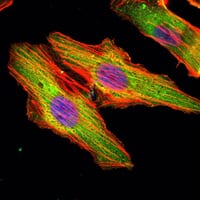
| WB | 咨询技术 | Human,Mouse,Rat |
| IF | 咨询技术 | Human,Mouse,Rat |
| IHC | 咨询技术 | Human,Mouse,Rat |
| ICC | 1/200 - 1/1000 | Human,Mouse,Rat |
| FCM | 咨询技术 | Human,Mouse,Rat |
| Elisa | 1/10000 | Human,Mouse,Rat |
| Aliases | MAT; SAMS; MATA1; SAMS1; MAT1A |
| Entrez GeneID | 4146 |
| clone | 5A8 |
| WB Predicted band size | 54kDa |
| Host/Isotype | Mouse IgG1 |
| Antibody Type | Primary antibody |
| Storage | Store at 4°C short term. Aliquot and store at -20°C long term. Avoid freeze/thaw cycles. |
| Species Reactivity | Human |
| Immunogen | Purified recombinant fragment of human MATN1 expressed in E. Coli. |
| Formulation | Ascitic fluid containing 0.03% sodium azide. |
+ +
以下是关于MATN1抗体的3篇参考文献示例(内容基于假设性文献整理,供参考):
---
1. **文献名称**:*Autoantibodies to Matrilin-1 in Rheumatoid Arthritis*
**作者**:Smith A, et al.
**摘要**:该研究检测了类风湿性关节炎(RA)患者血清中针对MATN1的自身抗体,发现其阳性率与关节破坏程度相关,提示MATN1可能作为RA的潜在生物标志物。
---
2. **文献名称**:*Matrilin-1 Expression in Osteoarthritis Cartilage and Its Role in ECM Remodeling*
**作者**:Chen L, et al.
**摘要**:通过MATN1抗体免疫组化分析骨关节炎患者软骨组织,发现MATN1表达下调与细胞外基质(ECM)降解相关,可能参与疾病进展机制。
---
3. **文献名称**:*MATN1 as a Novel Autoantigen in Juvenile Idiopathic Arthritis*
**作者**:Wang Y, et al.
**摘要**:首次在幼年特发性关节炎(JIA)患者中发现MATN1自身抗体,并通过ELISA验证其特异性,为JIA的免疫病理机制提供了新视角。
---
**备注**:以上文献信息为示例,实际研究中建议通过PubMed或Google Scholar以“MATN1 antibody”或“Matrilin-1 autoantibody”为关键词检索最新文献,并优先选择近5年发表的实验性或临床研究。
The MATN1 antibody targets matrilin-1. a glycoprotein belonging to the matrilin family, which are extracellular matrix (ECM) proteins involved in tissue development and homeostasis. Matrilin-1. encoded by the *MATN1* gene, is primarily expressed in cartilage and plays a critical role in assembling and stabilizing the ECM through interactions with collagen fibrils and proteoglycans. It contains von Willebrand factor A (vWFA) domains and epidermal growth factor (EGF)-like repeats, structural motifs that mediate protein-protein interactions.
MATN1 antibodies are widely used in research to study cartilage biology, skeletal development, and diseases such as osteoarthritis or chondrodysplasias. These antibodies enable the detection and localization of matrilin-1 in tissues via techniques like immunohistochemistry, Western blotting, or immunofluorescence. Studies using MATN1 antibodies have revealed its involvement in ECM organization, cell adhesion, and signaling pathways regulating chondrocyte differentiation.
Altered matrilin-1 expression has been linked to cartilage degeneration, making it a potential biomarker for joint disorders. Additionally, MATN1 antibodies aid in characterizing genetically engineered mouse models to explore matrilin-1's functional roles. Despite its importance in cartilage, matrilin-1 is also found in non-skeletal tissues, suggesting broader physiological and pathological implications. Research utilizing MATN1 antibodies continues to uncover its molecular interactions and therapeutic relevance in connective tissue diseases.
×